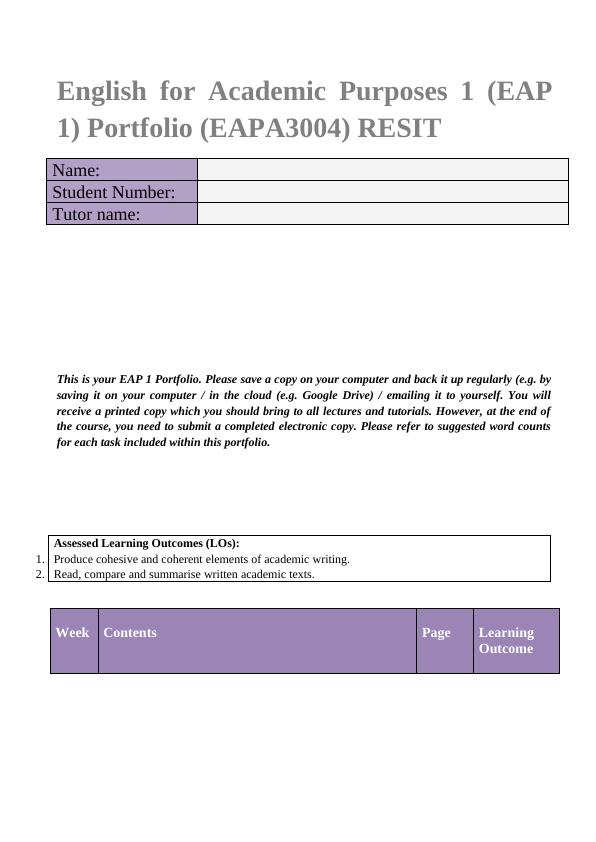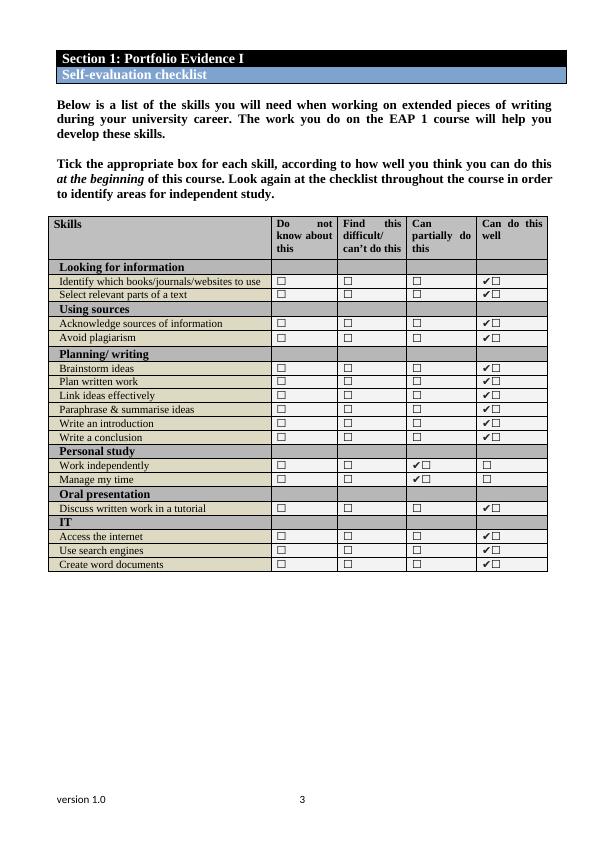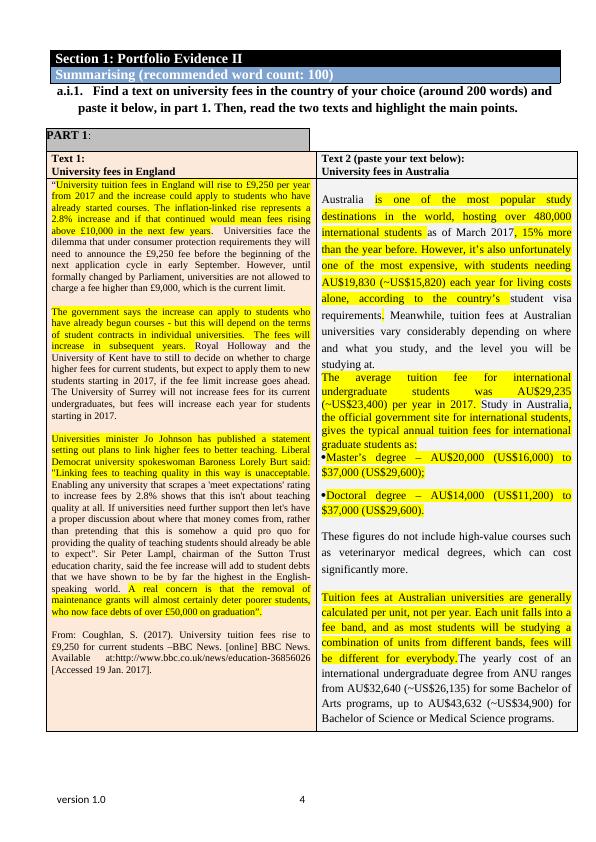Ask a question from expert
English for Academic Purposes - EAPA3004
14 Pages4974 Words60 Views
Added on 2020-07-22
English for Academic Purposes - EAPA3004
Added on 2020-07-22
BookmarkShareRelated Documents
English for Academic Purposes 1 (EAP1) Portfolio (EAPA3004) RESITName: Student Number:Tutor name:This is your EAP 1 Portfolio. Please save a copy on your computer and back it up regularly (e.g. bysaving it on your computer / in the cloud (e.g. Google Drive) / emailing it to yourself. You willreceive a printed copy which you should bring to all lectures and tutorials. However, at the end ofthe course, you need to submit a completed electronic copy. Please refer to suggested word countsfor each task included within this portfolio. Assessed Learning Outcomes (LOs):1.Produce cohesive and coherent elements of academic writing.2.Read, compare and summarise written academic texts.WeekContentsPageLearningOutcome

Section 1: PortfolioEvidence(These tasks will often bedrafted in class and aredesigned to inform thewritten task in section 2.Suggested word countsare included are inbrackets.)1Portfolio evidence I: Self-evaluation checklist3LO 1 & 24Portfolio evidence II: Summarising(recommended word count: 100)4LO 1 & 24-5Portfolio evidence III: Outline(recommended word count: 100)6LO 26Portfolio evidence IV: Paragraph structure(recommended word count: 250)7LO 29Portfolio evidence V: Self-assessment(recommended word count: at least 100)8LO 1 & 2Section 2: WrittenTask(The written task shouldbe developed throughoutthe semester butcompleted in weeks 7-10.)1 - 10Academic writing [compare and contrast essay relevant to highereducation](word count: 750 words)10LO 1 & 2Total word count: Written Task (750 words) + Evidence (Approx. 850 words)(+/- 10%)version 1.0 2

Section 1: Portfolio Evidence ISelf-evaluation checklistBelow is a list of the skills you will need when working on extended pieces of writingduring your university career. The work you do on the EAP 1 course will help youdevelop these skills. Tick the appropriate box for each skill, according to how well you think you can do thisat the beginning of this course. Look again at the checklist throughout the course in orderto identify areas for independent study.SkillsDo notknow aboutthisFind thisdifficult/can’t do thisCanpartially dothisCan do thiswellLooking for informationIdentify which books/journals/websites to use☐☐☐✔☐Select relevant parts of a text☐☐☐✔☐Using sourcesAcknowledge sources of information☐☐☐✔☐Avoid plagiarism☐☐☐✔☐Planning/ writingBrainstorm ideas☐☐☐✔☐Plan written work☐☐☐✔☐Link ideas effectively☐☐☐✔☐Paraphrase & summarise ideas☐☐☐✔☐Write an introduction☐☐☐✔☐Write a conclusion☐☐☐✔☐Personal studyWork independently☐☐✔☐☐Manage my time☐☐✔☐☐Oral presentationDiscuss written work in a tutorial☐☐☐✔☐ITAccess the internet☐☐☐✔☐Use search engines☐☐☐✔☐Create word documents☐☐☐✔☐version 1.0 3

Section 1: Portfolio Evidence IISummarising (recommended word count: 100)a.i.1.Find a text on university fees in the country of your choice (around 200 words) andpaste it below, in part 1. Then, read the two texts and highlight the main points.PART 1:Text 1:University fees in EnglandText 2 (paste your text below):University fees in Australia“University tuition fees in England will rise to £9,250 per yearfrom 2017 and the increase could apply to students who havealready started courses. The inflation-linked rise represents a2.8% increase and if that continued would mean fees risingabove £10,000 in the next few years. Universities face thedilemma that under consumer protection requirements they willneed to announce the £9,250 fee before the beginning of thenext application cycle in early September. However, untilformally changed by Parliament, universities are not allowed tocharge a fee higher than £9,000, which is the current limit.The government says the increase can apply to students whohave already begun courses - but this will depend on the termsof student contracts in individual universities. The fees willincrease in subsequent years. Royal Holloway and theUniversity of Kent have to still to decide on whether to chargehigher fees for current students, but expect to apply them to newstudents starting in 2017, if the fee limit increase goes ahead.The University of Surrey will not increase fees for its currentundergraduates, but fees will increase each year for studentsstarting in 2017.Universities minister Jo Johnson has published a statementsetting out plans to link higher fees to better teaching. LiberalDemocrat university spokeswoman Baroness Lorely Burt said:"Linking fees to teaching quality in this way is unacceptable.Enabling any university that scrapes a 'meet expectations' ratingto increase fees by 2.8% shows that this isn't about teachingquality at all. If universities need further support then let's havea proper discussion about where that money comes from, ratherthan pretending that this is somehow a quid pro quo forproviding the quality of teaching students should already be ableto expect". Sir Peter Lampl, chairman of the Sutton Trusteducation charity, said the fee increase will add to student debtsthat we have shown to be by far the highest in the English-speaking world. A real concern is that the removal ofmaintenance grants will almost certainly deter poorer students,who now face debts of over £50,000 on graduation”.From: Coughlan, S. (2017). University tuition fees rise to£9,250 for current students –BBC News. [online] BBC News.Available at:http://www.bbc.co.uk/news/education-36856026[Accessed 19 Jan. 2017].Australiais one of the most popular studydestinations in the world, hosting over 480,000international students as of March 2017, 15% morethan the year before. However, it’s also unfortunatelyone of the most expensive, with students needingAU$19,830 (~US$15,820) each year for living costsalone, according to the country’s student visarequirements. Meanwhile, tuition fees at Australianuniversities vary considerably depending on whereand what you study, and the level you will bestudying at.The average tuition fee for internationalundergraduate students was AU$29,235(~US$23,400) per year in 2017. Study in Australia,the official government site for international students,gives the typical annual tuition fees for internationalgraduate students as:Master’s degree – AU$20,000 (US$16,000) to$37,000 (US$29,600);Doctoral degree – AU$14,000 (US$11,200) to$37,000 (US$29,600).These figures do not include high-value courses suchas veterinaryor medical degrees, which can costsignificantly more.Tuition fees at Australian universities are generallycalculated per unit, not per year. Each unit falls into afee band, and as most students will be studying acombination of units from different bands, fees willbe different for everybody.The yearly cost of aninternational undergraduate degree from ANU rangesfrom AU$32,640 (~US$26,135) for some Bachelor ofArts programs, up to AU$43,632 (~US$34,900) forBachelor of Science or Medical Science programs.version 1.0 4

End of preview
Want to access all the pages? Upload your documents or become a member.
Related Documents
EAPA3004 Residual (EAPA 3004)lg...
|12
|4106
|52
EAP Portfolio (EAPA3004)lg...
|17
|4896
|143
EAPA3004 : English for Academic Purposes Assignmentlg...
|17
|4460
|58
EAPA3004 English for Academic Purpose Assignmentlg...
|15
|4362
|227
Portfolio (EAPA3004) Assignmentlg...
|15
|4325
|406
EAP 1 Portfoliolg...
|15
|4660
|186